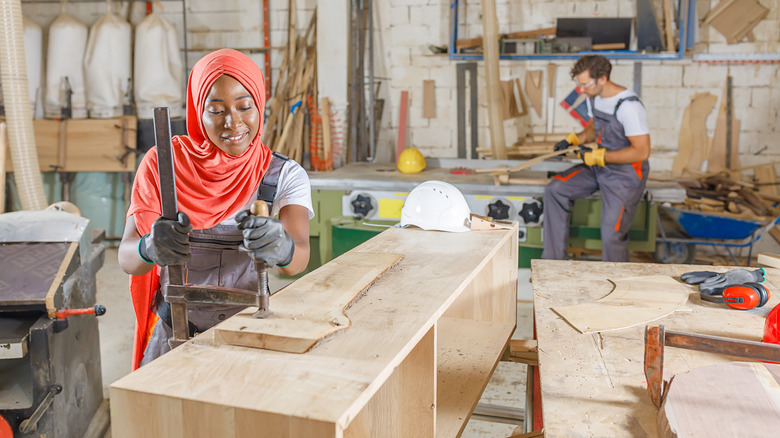Pro Tips To Avoid A Sticky Glue Mess When Using Clamps For DIY Projects
Using glue and clamps to stick boards together is something every woodworker has to do, but it's one of those processes that should have evolved by now. Even when you do it properly, you get something called "squeeze-out" — excess glue that is pushed out of the joint by vice pressure. You have to clean it up or pay the price, which includes wood that is impossible to finish and clamps that are gummed up with drips of glue. Typical PVA wood adhesive technically only creates a weak bond with metal — what most clamp bars are made of — but it's strong enough to be annoying and time-consuming to release. YouTuber Small Workshop Guy has a solution, and it's a pretty straightforward idea: Apply wax.
It might seem like waxing a mechanism that's meant to hold something in place is a bad idea. But most bar clamps use notches as a way to physically hold its sliding head in place rather than simple friction, so the wax shouldn't cause a substantial problem. Small Workshop Guy uses what appears to be an old tub of Turtle Wax, a blend of carnauba and synthetic waxes that's formulated for waxing cars. With the coating in place, he's able to easily remove dried — or (shudder) cured — wood glue drips with a sharp chisel. However, he mentions using a propane torch or a wire brush if the chisel doesn't do the trick. (Obviously, you'll need gentler hacks to remove excess glue from the wood itself.)
Other approaches, and a better wax
In an older video, Small Workshop Guy discusses the various ways to remove dried wood glue from a clamp, like a white vinegar bath, a solvent specifically made for softening water-based glues like PVA, or using a propane torch to soften the glue before scraping it off. Prevention is better than a cure, of course, so the wax approach is a better idea — if it works. "Working" seems to mean creating a physical barrier so that the glue doesn't bond to the wood. Many woodworkers try using painter's tape, wax paper, or even 3D-printed clip-on sleeves for this barrier, all of which add substantial time and material costs. A coating of wax or sealant seems to be the generally preferred method, and options include paste wax, beeswax, paraffin wax, or a silicone lubricant like mold release spray.
Many woodworkers already have a tin of paste wax (usually Minwax) around for protecting and adding glide to surfaces like table saw tops. It's also useful for other tasks like protecting outdoor furniture from rust and even to keep wood from splitting when you screw it together. Minwax paste wax contains paraffin, mineral spirits, and turpentine (the brand also mentions carnauba wax, but it isn't listed in the product's material data sheet). Applying it to clamp bars every few months seems to be the go-to way to keep the wood glue at bay. YouTuber The Rookie Woodworker tested mold release spray against paste wax and got slightly better performance from the wax. Good coverage appears to make all the difference, and a solid mixture might be easier to distribute thoroughly than a silicone spray.
